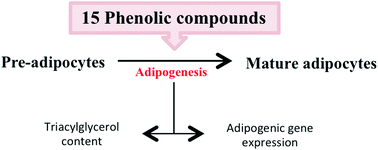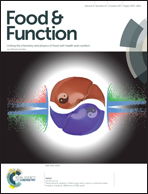Screening of potential anti-adipogenic effects of phenolic compounds showing different chemical structure in 3T3-L1 preadipocytes†
Abstract
This study was designed to analyze the anti-adipogenic effect of fifteen phenolic compounds from various chemical groups in 3T3-L1 pre-adipocytes. Cells were treated with 25 μM, 10 μM or 1 μM of apigenin, luteolin, catechin, epicatechin, epigallocatechin, genistein, daizein, naringenin, hesperidin, quercetin, kaempferol, resveratrol, vanillic acid, piceatannol and pterostilbene for 8 days. At 25 μM lipid accumulation was reduced by all the compounds, with the exception of catechin, epicatechin and epigallocatechin. At a dose of 10 μM apigenin, luteolin, naringenin, hesperidin, quercetin and kaempferol induced significant reductions, and at 1 μM only naringenin, hesperidin and quercetin were effective. The expression of c/ebpα was not. C/ebpβ was significantly reduced by genistein and kaempferol, pparγ by genistein and pterostilbene, srebp1c by luteolin, genistein, hesperidin, kaempferol, pterostilbene and vanillic acid, and lpl by kaempferol. In conclusion, the most effective phenolic compounds are naringenin, hesperidin and quercetin. Differences were found in terms of effects on the expression of genes involved in adipogenesis among the analyzed compounds.



 Please wait while we load your content...
Please wait while we load your content...